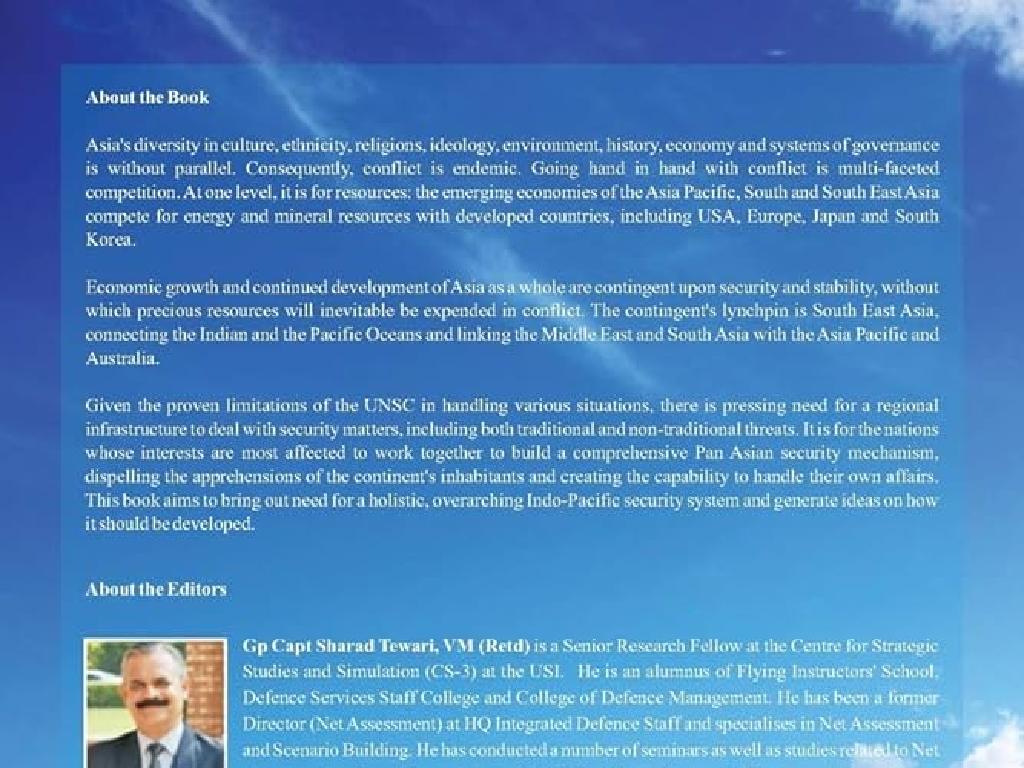Identify And Select Countries Of Asia: Region 5
Subject: Social studies
Grade: Seventh grade
Topic: Asia: Geography
Please LOG IN to download the presentation. Access is available to registered users only.
View More Content
Exploring Asia: Region 5 Geography
– Asia’s vastness and diversity
– Asia is the largest continent with diverse cultures and landscapes.
– What are geographical regions?
– Geographical regions are areas with distinct physical, political, and cultural characteristics.
– Focus on Asia’s Region 5
– Region 5 includes countries like Thailand, Vietnam, and Myanmar.
– Significance of regional study
– Understanding regions helps us appreciate the unique aspects of different areas.
|
This slide introduces students to the geography of Asia, emphasizing its size and the concept of geographical regions. Region 5, which we will focus on today, includes Southeast Asian countries known for their rich history and cultural heritage. Encourage students to think about how a region’s geography can influence the culture and daily life of its inhabitants. Provide a map for visual reference and discuss the importance of studying geography to understand global diversity. In the next class, we will delve deeper into the specific countries of Region 5, exploring their individual characteristics and contributions to the continent’s tapestry.
Exploring Asia: Focus on Region 5
– What defines Region 5?
– Region 5 refers to a specific area in Asia, often categorized for study.
– Countries within Region 5
– Includes countries like Thailand, Vietnam, and Malaysia.
– Geographical boundaries
– Bounded by specific natural and political borders.
– Significance of learning Region 5
– Understanding cultural, political, and economic dynamics.
|
This slide introduces students to Region 5 of Asia, which is a classification used to facilitate the study of this vast continent. It’s important to clarify what countries are included in this region and discuss its geographical boundaries, which may include mountains, rivers, and man-made borders. Emphasize the importance of learning about Region 5 by highlighting its unique cultural, political, and economic aspects. This knowledge helps students gain a broader understanding of Asia’s role in global affairs and the diversity within the continent itself. Encourage students to research more about each country’s individual characteristics and how they contribute to the identity of Region 5.
Exploring Asia: Region 5 Countries
– List Region 5 countries
– Identify countries like Thailand, Malaysia, Singapore, etc.
– Capitals and languages
– Learn capitals like Bangkok, Kuala Lumpur, and languages like Thai, Malay
– Unique geographical features
– Explore features like Thailand’s beaches, Malaysia’s Mount Kinabalu
– Cultural significance
|
This slide aims to familiarize students with the countries of Asia’s Region 5, their capital cities, official languages, and unique geographical features. Start by presenting the list of countries in this region, which includes Thailand, Malaysia, Singapore, and others. Highlight the capital cities and the languages spoken in these countries to give students a sense of the cultural diversity within the region. Discuss the unique geographical features, such as Thailand’s renowned beaches or Malaysia’s Mount Kinabalu, to spark interest in the physical geography of each country. Emphasize the importance of understanding the cultural and geographical diversity of Asia as it contributes to the global community. Encourage students to research more about these countries for a deeper understanding.
Exploring Asia: Region 5 Geography
– Mountains, rivers, and climate overview
– Explore the Himalayas, Mekong River, and monsoon patterns
– Region 5’s natural resources
– Discover resources like rice, tea, and rare minerals
– Geography’s impact on daily life
– How do mountains and rivers affect settlements and jobs?
– Significance of geographical features
|
This slide aims to give students a comprehensive understanding of the physical geography of Asia’s Region 5. Start by discussing prominent geographical features such as the Himalayas and the Mekong River, and explain how these affect the climate, particularly the monsoon weather patterns. Highlight the abundance of natural resources like rice and tea, which are pivotal to the economies of these regions. Discuss how the geography influences where people live, the types of jobs they have, and their daily lives, emphasizing the relationship between the environment and human activities. Encourage students to think about how living near a river or mountain might influence their own lives to draw parallels and deepen understanding.
Cultural Highlights of Asia: Region 5
– Diversity in Region 5 cultures
– Region 5 includes countries with unique languages, customs, and beliefs.
– Festivals, traditions, and attire
– Diwali in India, Hanbok clothing in Korea, and the Dragon Boat Festival in China.
– Geography’s impact on culture
– Mountainous terrain, rivers, and climate shape local lifestyles and traditions.
– Exploring cultural uniqueness
|
This slide aims to give students a glimpse into the rich and varied cultures of Asia’s Region 5. Highlight the diversity found within this region, including different languages, religions, and social customs. Discuss how festivals like Diwali in India, traditional clothing such as the Hanbok in Korea, and events like the Dragon Boat Festival in China are integral to cultural identity. Explain how geography, including physical features and climate, influences the cultural practices of the people living in this area. Encourage students to explore the uniqueness of each culture and consider how geography and history have shaped these communities. This discussion can lead to a deeper understanding of cultural diversity and the factors that contribute to it.
Economic Overview of Asia: Region 5
– Major industries and agriculture
– Key sectors: technology, manufacturing, farming
– Trade and economic growth
– Exports boost economies, trade agreements
– Geography’s impact on economy
– Terrain, climate influence economic activities
|
This slide provides an overview of the economic landscape in Asia’s Region 5, focusing on the major industries, agricultural practices, trade policies, and the overall economic growth. Emphasize the diversity of economies in this region, from technology-driven industries to traditional agriculture. Discuss how geography, including factors like terrain and climate, can affect economic activities and opportunities. Highlight the importance of trade and economic partnerships in fostering growth. Encourage students to think about how the physical landscape of a country can shape its economy and the types of industries that thrive there.
Challenges and Opportunities in Asia: Region 5
– Region 5’s environmental issues
– Issues like deforestation, pollution, and water scarcity.
– Economic and social prospects
– Opportunities such as tourism, technology, and trade.
– Strategies tackling challenges
– Policies on conservation, sustainable development.
– Case studies of progress
– Examples: afforestation projects, clean energy initiatives.
|
This slide aims to discuss the environmental challenges faced by countries in Asia’s Region 5, such as deforestation, pollution, and water scarcity, and how these issues affect both urban and rural populations. It also highlights the economic and social opportunities available in the region, including the potential for growth in tourism, technology, and international trade. Furthermore, the slide will cover the various strategies that countries are implementing to address these challenges, including government policies on conservation and sustainable development. To provide a concrete understanding, case studies of progress, such as successful afforestation projects and clean energy initiatives, will be presented. Encourage students to think critically about how these challenges and opportunities are interconnected and the role of international cooperation in addressing global issues.
Class Activity: Exploring Asia’s Region 5
– Interactive map identification
– Use the map to find and mark Region 5 countries
– Group discussion on geography’s impact
– Discuss how mountains, rivers, etc., influence lifestyle
– Create a travel brochure
– Pick a country from Region 5 and design a brochure
– Share and reflect on your findings
|
This activity is designed to engage students with the geography of Asia’s Region 5 through hands-on learning and creative expression. Begin with an interactive map activity where students identify and locate countries within Region 5. Then, facilitate a group discussion to explore how geographical features like mountains and rivers can shape the culture and daily life of people living in those countries. Next, students will create a travel brochure for a country in Region 5, which will require research and creativity, allowing them to delve deeper into the country’s culture, landmarks, and attractions. Conclude with students sharing their brochures and reflecting on what they learned about the relationship between geography and culture. Provide guidance and ensure each student or group has access to the necessary materials for the brochure creation.






